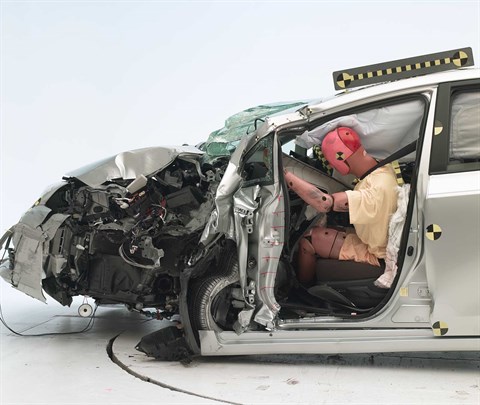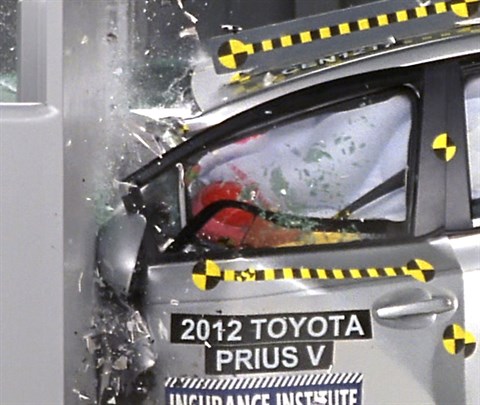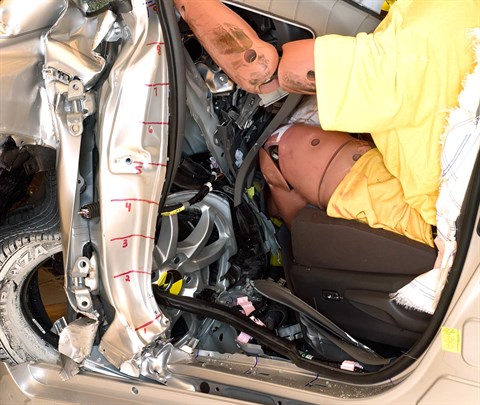Small overlap front: driver-side
Rating applies to 2012-14 models
Tested vehicle: 2012 Toyota Prius v Two wagon
The Toyota Prius v wagon was introduced in the 2012 model year. It is derived from the Toyota Prius but is longer and taller to provide more rear seat room and cargo-carrying capacity.
| Evaluation criteria | Rating |
|---|---|
| Structure and safety cage | |
| Driver injury measures | |
| Head/neck | |
| Chest | |
| Hip/thigh | |
| Lower leg/foot | |
| Driver restraints and dummy kinematics The dummy’s head barely contacted the frontal airbag before sliding off the left side as the steering column moved 13 cm to the right. Additionally, the seat belt allowed excessive forward excursion of the dummy’s head and torso, permitting the head to hit the instrument panel. The side curtain airbag deployed too late during the crash, dropping onto the back of the head and pushing it outboard of the inflating curtain, leaving the dummy's head vulnerable to contact with side structure and outside objects. The side torso airbag deployed. | |

Action shot taken during the small overlap frontal crash test.

The dummy's position in relation to the door frame, steering wheel, and instrument panel after the crash test indicates that the driver's survival space was not maintained well.

During the crash, the dummy's head barely contacted the frontal airbag before sliding off to the left, and the seat belt allowed the dummy to move too far forward, with the head hitting the instrument panel. The side curtain airbag deployed too late to offer any head protection, leaving the dummy's head exposed to contact with side structure and outside objects.

Intrusion into the occupant compartment was extensive as the left front wheel was forced rearward and inward into the door hinge pillar, driver footwell, and instrument panel during the crash. Left hip and left lower leg injury risk was high.
Moderate overlap front: original test
Rating applies to 2012-17 models
Tested vehicle: 2012 Toyota Prius v wagon
The Toyota Prius v wagon was introduced in the 2012 model year. It is derived from the Toyota Prius but is longer and taller to provide more rear seat room and cargo-carrying capacity. Moderate overlap frontal ratings are assigned by the Institute based on a test conducted by Toyota.
| Evaluation criteria | Rating |
|---|---|
| Overall evaluation | |
| Structure and safety cage | |
| Driver injury measures | |
| Head/neck | |
| Chest | |
| Leg/foot, left | |
| Leg/foot, right | |
| Driver restraints and dummy kinematics | |
Side: original test
Rating applies to 2013-17 models
Tested vehicle: 2013 Toyota Prius v Three wagon with standard front and rear head curtain airbags and standard front seat-mounted torso airbags
The Toyota Prius v wagon was introduced in the 2012 model year. It is derived from the Toyota Prius but is longer and taller to provide more rear seat room and cargo-carrying capacity. Beginning with 2013 models, design changes were made to the front and rear door trim panels to improve occupant protection in side impact crashes.
Two tests of the Prius v were conducted, one of a 2012 model by the Institute and the other representing a 2013 model by Toyota. These vehicles are rated separately, except that the structure ratings for both vehicles are based on both tests. (The car tested by Toyota was designated as a 2012 model but included the front and rear door trim changes of the 2013 models.)
| Evaluation criteria | Rating |
|---|---|
| Overall evaluation | |
| Structure and safety cage | |
| Driver injury measures | |
| Head/neck | |
| Torso | |
| Pelvis/leg | |
| Driver head protection | |
| Rear passenger injury measures | |
| Head/neck | |
| Torso | |
| Pelvis/leg | |
| Rear passenger head protection The dummy's head pushed past the side curtain airbag and was hit by the window frame of the passenger door. This impact did not produce high head injury measures, but the head protection is inadequate. | |
Roof strength
Rating applies to 2012-17 models
Tested vehicle: 2012 Toyota Prius v Two wagon
| Overall evaluation | |
|---|---|
| Curb weight | 3,274 lbs |
| Peak force | 14,180 lbs |
| Strength-to-weight ratio | 4.33 |
Head restraints & seats
Seat type: Manual cloth seats
| Overall evaluation | |
|---|---|
| Dynamic rating | |
| Seat/head restraint geometry |
About the head restraint & seat test
Currently, IIHS tests apply only to front seats.
